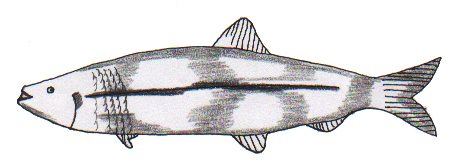 Marshall
Cultural Atlas Marshall
Cultural Atlas
This collection of student work is from
Frank Keim's classes. He has wanted to share these works for others
to use as an example of Culturally-based curriculum and documentation. These
documents have been OCR-scanned. These are available
for educational use only.

Pacific Herring
(Clupea Pallasii)
(Iqalluarpak)
The Pacific herring is one of more than 180
species in the herring family, Clupeidae. This family contains the
world's most abundant and commercially important fishes. Herring also
are an important food source for a wide variety of fishes mammals and
birds.
Herring have a blue-green upper body with silvery
sides and are devoid of markings. The body is compressed and the
scales are along the underside. Their scales are large and easily
removed. These fish may grow to 18 inches in length but an eight inch
specimen is considered large.
Pacific herring generally spawn during the spring.
In Alaska, spawning is first observed in Southeast Alaska during
mid-March, in Prince William Sound in April and May, and at Kodiak
during May and June. The eggs are adhesive and survival is better for
those eggs which stick to intertidal vegetation than for those which
fall to the bottom. Milt released by the male drifts among the eggs
and fertilizes them. Herring spawn every year after reaching sexual
maturity at three or four years of age. The number of eggs varies
with the age of the fish and averages 20,000 annually. Average life
span for these fish is about eight years. Mortality of the eggs is
estimated at 56 to 99 per cent, depending on locality and
environmental conditions at the time of spawning and during
incubation. The major sources of mortality are wave action, predation
and exposure at low tide.
Herring are located in different environments
during different periods of the year. After spawning, most adults
leave inshore waters and move offshore to feed primarily on
zooplankton such as copopods and other crustaceans. They are seasonal
feeders and store fat reserves for periods of relative inactivity.
They swim in large schools in the fall and move inshore to winter in
deep bays.
Alaska's herring industry began in 1878 when
30,000 pounds were marketed for human consumption. Herring are now
harvested primarily for use as bait for the halibut, crab and salmon
troll fisheries and also for their roe which is sold to the
Japanese.
Cheryl
Hunter
Christmastime Tales
Stories real and imaginary about Christmas, Slavik, and the New Year
Winter, 1996 |
Christmastime Tales II
Stories about Christmas, Slavik, and the New Year
Winter, 1998 |
Christmastime Tales III
Stories about Christmas, Slavik, and the New Year
Winter, 2000 |
| Summer Time Tails 1992 |
Summertime Tails II 1993 |
Summertime Tails III |
| Summertime Tails IV Fall, 1995 |
Summertime Tails V Fall, 1996 |
Summertime Tails VI Fall, 1997 |
| Summertime Tails VII Fall, 1999 |
Signs of the Times November 1996 |
Creative Stories From Creative Imaginations |
| Mustang Mind Manglers - Stories of the Far Out,
the Frightening and the Fantastic 1993 |
Yupik Gourmet - A Book of
Recipes |
|
| M&M Monthly |
|
|
| Happy Moose Hunting! September Edition 1997 |
Happy Easter! March/April 1998 |
Merry Christmas December Edition 1997 |
| Happy Valentine’s
Day! February Edition
1998 |
Happy Easter! March/April Edition 2000 |
Happy Thanksgiving Nov. Edition, 1997 |
| Happy Halloween October 1997 Edition |
Edible and Useful Plants of Scammon
Bay |
Edible Plants of Hooper Bay 1981 |
| The Flowers of Scammon Bay Alaska |
Poems of Hooper Bay |
Scammon Bay (Upward Bound Students) |
| Family Trees and the Buzzy Lord |
It takes a Village - A guide for parents May 1997 |
People in Our Community |
| Buildings and Personalities of
Marshall |
Marshall Village PROFILE |
Qigeckalleq Pellullermeng ‘A
Glimpse of the Past’ |
| Raven’s
Stories Spring 1995 |
Bird Stories from Scammon Bay |
The Sea Around Us |
| Ellamyua - The Great Weather - Stories about the
Weather Spring 1996 |
Moose Fire - Stories and Poems about Moose November,
1998 |
Bears Bees and Bald Eagles Winter 1992-1993 |
| Fish Fire and Water - Stories about fish, global warming
and the future November, 1997 |
Wolf Fire - Stories and Poems about Wolves |
Bear Fire - Stories and Poems about Bears Spring,
1992 |
|